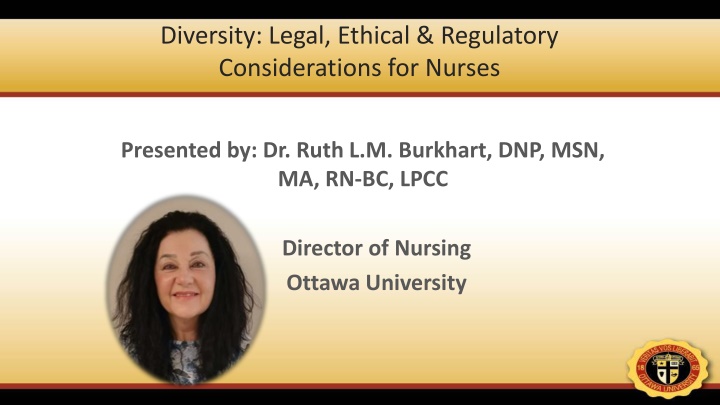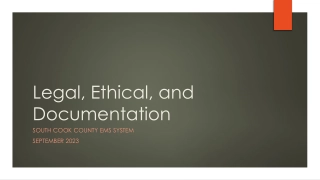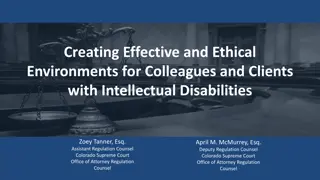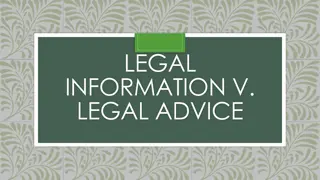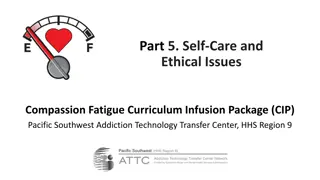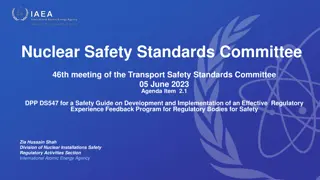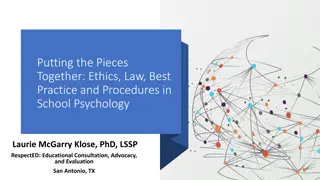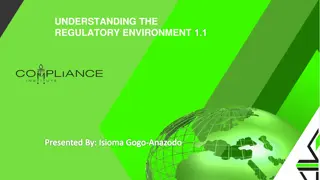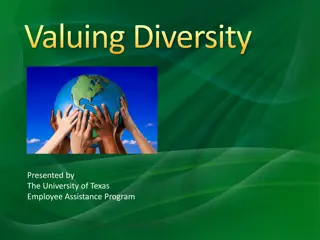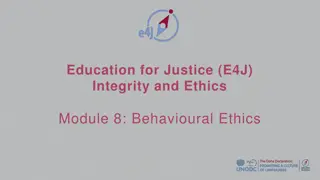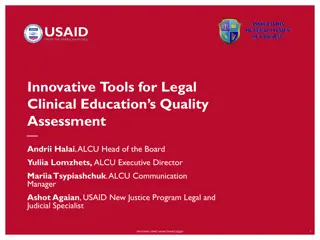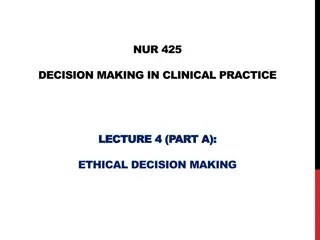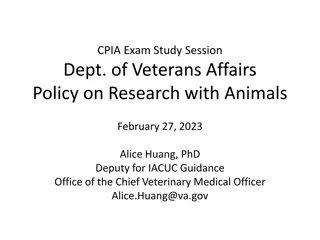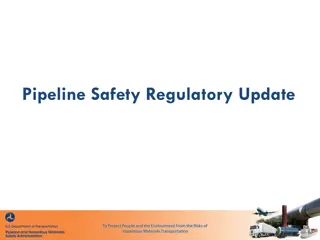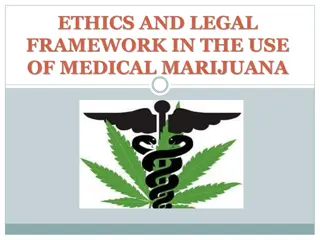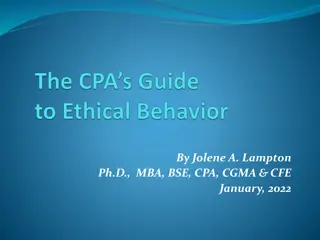Diversity: Legal, Ethical & Regulatory
Presented by Dr. Ruth L.M. Burkhart, this activity explores the importance of diversity in nursing, covering legal, ethical, and regulatory aspects. Topics include diversity definitions, DEI principles, and the unique role of nurses in fostering inclusive environments. The content delves into critical factors such as equity, inclusion, and communication in nursing practice.
Download Presentation

Please find below an Image/Link to download the presentation.
The content on the website is provided AS IS for your information and personal use only. It may not be sold, licensed, or shared on other websites without obtaining consent from the author.If you encounter any issues during the download, it is possible that the publisher has removed the file from their server.
You are allowed to download the files provided on this website for personal or commercial use, subject to the condition that they are used lawfully. All files are the property of their respective owners.
The content on the website is provided AS IS for your information and personal use only. It may not be sold, licensed, or shared on other websites without obtaining consent from the author.
E N D
Presentation Transcript
Diversity: Legal, Ethical & Regulatory Considerations for Nurses Presented by: Dr. Ruth L.M. Burkhart, DNP, MSN, MA, RN-BC, LPCC Director of Nursing Ottawa University
Disclosure Statement Activity Title:Diversity: Legal, Ethical & Regulatory Considerations for Nurses Activity Date:8/15/2022 - 8/15/2024 Disclosure Action 1. Approval Statement This activity has been submitted to the Arizona Nurses Association for approval to award contact hours. The Arizona Nurses Association is accredited as an approver of nursing continuing professional development by the American Nurses Credentialing Center s Commission on Accreditation. 2. Criteria for Successful Completion an evaluation of the event. 3. Conflicts of Interest Presence or absence of conflicts of interest for all individuals in a position to control content (e.g. the Planning Committee, presenters, faculty, authors, and content reviewers) 4. Commercial Support There is no commercial support being received for this event. 5. Joint Provider(s) if applicableN/A 6.Expiration date for Enduring Materials if applicable Expiration Date: 8/15/2024 Participants: Please note that it should take approximately 120 minutes (2 hours) to complete the continuing education offering followed by a posttest and evaluation. Participants must complete a post test at 80% or greater and This educational activity does not include any content that relates to the products and/or services of a commercial interest that would create a conflict of interest. Origination Date: 8/15/2022
Diversitysometimes we miss the whole picture (unsplash.com, n.d.)
Diversity: What is it? Definition of Diversity 1: the condition of having or being composed of differing elements: variety especially : the inclusion of people of different races, cultures, etc. in a group or organization programs intended to promote diversity in schools 2: an instance of being composed of differing elements or qualities : an instance of being diverse, a diversity of opinion (Merriam-Webster Dictionary, 2022, para 1).
DEI: Quality AND Regulatory Issue Diversity, Equity & Inclusion Diversity .. Broad array of Individual, group, & social characteristic differences Equity .. Systems and actions to ensure fairness, identifying, & removing barriers to the same opportunities for all Inclusion .. Ensuring organizational & social structures and cultures allow people with diverse characteristics to flourish (American Association of Colleges of Nursing (2021). Diversity, equity, and inclusion in academic nursing. https://www.aacnnursing.org/News-Information/Position- Statements-White-Papers/Diversity
Diversity in Nursing: Why this Matters What s it all about? Why is this important in nursing? Hint: it s not just about culture & personal bias Unique Role of the Nurse Understanding of Communication is Essential Engagement & Trust Building
Nursing Actions = Life or Death Assessment, Judgment, & Actions by the Nurse involve Public Safety & Concern Role of the Nurse is Unique Holistic Approach, often Longer Care Episodes than other Team Disciplines Misunderstandings in Communication or Bias Could Mean Injury or Death for the Patient Diversity, Equity, & Inclusion Prevent Both (American Nurses Association, 2022).
Office of Minority Health Website Think Cultural Health https://www.minorityhealth.hhs.gov/omh/brow se.aspx?lvl=2&lvlid=53 The ADDRESSING framework mnemonic helps remember the (10) key social identities to consider (Office of Minority Health, 2021)
(10) Social Identities of the ADDRESSING framework A = Age & Generational Influences D = Disability Status (developmental) D = Disability Status (acquired) R = Religion & Spirituality E = Ethnicity & Race S = Socioeconomic Status (SES) S = Sexual Orientation I = Indigenous Heritage N = National Origin G = Gender Identity
The Legal, Ethical & Regulatory view National CLAS standards (Office of Minority Health, 2013) . Enhanced Culturally and Linguistically Appropriate Services . 15 Standards . Federal requirement for healthcare providers receiving federal funding . CLAS Standards toolkit (Office of Minority Health, 2016)
National CLAS Standards The National CLAS Standards are intended to advance health equity, improve quality, and help eliminate health care disparities by establishing a blueprint for health and health care organizations to: Principal Standard Provide effective, equitable, understandable, and respectful quality care and services that are responsive to diverse cultural health beliefs and practices, preferred languages, health literacy, and other communication needs. (Office of Minority Health.ThinkCulturalHealth,
National CLAS Standards 1-8 Governance, Leadership, and Workforce Advance and sustain organizational governance and leadership that promotes CLAS and health equity through policy, practices, and allocated resources. Recruit, promote, and support a culturally and linguistically diverse governance, leadership, and workforce that are responsive to the population in the service area. Educate and train governance, leadership, and workforce in culturally and linguistically appropriate policies and practices on an ongoing basis. Communication and Language Assistance Offer language assistance to individuals who have limited English proficiency and/or other communication needs, at no cost to them, to facilitate timely access to all health care and services. Inform all individuals of the availability of language assistance services clearly and in their preferred language, verbally and in writing. Ensure the competence of individuals providing language assistance, recognizing that the use of untrained individuals and/or minors as interpreters should be avoided. Provide easy-to-understand print and multimedia materials and signage in the languages commonly used by the populations in the service area.
National CLAS Standards 9-15 Engagement, Continuous Improvement, and Accountability 9. Establish culturally and linguistically appropriate goals, policies, and management accountability, and infuse them throughout the organization s planning and operations. 10. Conduct ongoing assessments of the organization s CLAS-related activities and integrate CLAS-related measures into measurement and continuous quality improvement activities. 11. Collect and maintain accurate and reliable demographic data to monitor and evaluate the impact of CLAS on health equity and outcomes and to inform service delivery. 12. Conduct regular assessments of community health assets and needs and use the results to plan and implement services that respond to the cultural and linguistic diversity of populations in the service area. 13. Partner with the community to design, implement, and evaluate policies, practices, and services to ensure cultural and linguistic appropriateness. 14. Create conflict and grievance resolution processes that are culturally and linguistically appropriate to identify, prevent, and resolve conflicts or complaints. 15. Communicate the organization s progress in implementing and sustaining CLAS to all stakeholders, constituents, and the general public. (Office of Minority Health. ThinkCulturalHealth, 2015)
NCSBN: National Council State Boards of Nursing NCSBN holds Key Position in Nursing Statement on Diversity and Equality in America Strong Support for Future of Nursing 2020-2030 . Charting a Path to Achieve Health Equity . Impacts Significance of Diversity, Equity, & Inclusion (DEI) Recommendation . Moves DEI toward Priority for Nursing . Increasing Diversity in Nursing Health Equity (National Council State Boards of Nursing, 2020)
The Future of Nursing, 2020-2030: Charting a Path to Achieve Health Equity . Published 2021 by National Academies of Sciences, Engineering and Medicine . Institute of Medicine s Future of Nursing 2010 Report set the standard in four key areas .Nurse practice to full extent of training .Streamlined education system to promote higher levels of nurse education .Nurses as full partners in redesign of US healthcare .Improved data collection & information systems (National Academies Press, 2021)
The American Nurses Association American Nurses Association (ANA) Position Statement . ANA Standard 8: Culturally Congruent Practice (2015) ( . No Discrimination Position Statement (2018) . Reinforces ANA s stance on Discrimination and nurse accountability to inclusive strategies for nursing care of all individuals of all ages and from all populations (American Nurses Association Ethics Advisory Board, 2018)
The National League for Nursing: Hallmarks of Excellence The NLN (National League for Nursing) Recognized Voice and Leader in Nursing since late 1800s NLN first Organization for Nurses in U.S. (1893), first Standards of Nursing (1917), renamed National League for Nursing in 1942, Recognized by U.S. Department of Education for first Nursing Accreditation NLN s Hallmarks of Excellence (2020) includes Importance of Diversity (National League for Nursing, 2020)
NLN: Hallmarks of Excellence Engaged Students Diverse, Well-Prepared Faculty A Culture of Continuous Quality Improvement Innovative, Evidence-Based Curriculum Innovative, Evidence-Based Approaches to Facilitate and Evaluate Learning Resources to Support Program Goal Attainment Commitment to Pedagogical Scholarship Effective Institutional and Professional Leadership (NLN, 2020)
NLN: Diversity Excellence Includes Faculty Diversity in More than Race/Ethnicity Category Policies, Hiring, Orientation, Mentoring Promote Faculty Diversity System of Faculty Accountability Promotes Faculty Diversity Organizational Culture Promotes Faculty Diversity (National League for Nursing, 2020)
The Nursing Code of Ethics The Significance of The Code Adherence to The Code is Not Optional The Code outlines Guidance Pertaining to Diversity, Equity, & Inclusion Provisions of the Code, Three Areas: 1-3, 4-6, 7-9 Outline Fundamental Nurse Values & Commitments, Boundaries of Duty & Loyalty, & Obligations
Nurses Code of Ethics Summary American Nurses Association Code of Ethics for Nurses The nurse practices with compassion and respect for the inherent dignity, worth, and unique attributes of every person. The nurse s primary commitment is to the patient, whether an individual, family, group, community, or population. The nurse promotes, advocates for, and protects the rights, health, and safety of the patient. The nurse has authority, accountability and responsibility for nursing practice; makes decisions; and takes action Provision 1 Provision 2 Provision 3 Provision 4 consistent with the obligation to provide optimal patient care. Provision 5 The nurse owes the same duties to self as to others, including the responsibility to promote health and safety, preserve wholeness of character and integrity, maintain competence, and continue personal and professional growth. Provision 6 The nurse, through individual and collective effort, establishes, maintains, and improves the ethical environment of the work setting and conditions of employment that are conducive to safe, quality health care. Provision 7 The nurse, in all roles and settings, advances the profession through research and scholarly inquiry, professional standards development, and the generation of both nursing and health policy. Provision 8 The nurse collaborates with other health professionals and the public to protect human rights, promote health diplomacy, and reduce health disparities. Provision 9 The profession of nursing, collectively through its professional organizations, must articulate nursing values, maintain the integrity of the profession and integrate principles of social justice into nursing and health policy. American Nurses Association. (2015). Code of ethics with interpretative statements. Silver Spring, MD: Author. Retrieved from http://www.nursingworld.org/MainMenuCategories/EthicsStandards/CodeofEthicsforNurses/Code-of-Ethics-For-Nurses.html
The Legal Angle: Nurses Want to Know . Questions: 1. Does the U.S. law protect Diversity, Equity, & Inclusion in the Healthcare Workplace? . Criminal versus Civil Charges? 1. Can a Nurse be Sued for Infractions related to Diversity, Equity, & Inclusion? 3. What could Happen to a Nurse if Accused? Manson, P. (30 July, 2021). Calif. court strikes law on transgender pronoun use in nursing homes. https://www.upi.com/Top_News/US/2021/07/30/transgender-pronouns-California-nursing-homes-lawsuit/4341627575533/ Nurses Service Organization (NSO) (2021). Creating inclusiveness for transgender patients. https://www.nso.com/Learning/Artifacts/Articles/Creating-Inclusiveness-for-Transgender-Patients
The U.S. Constitution: the First Amendment First of all the First Amendment Congress shall make no law respecting an establishment of religion, or prohibiting the free exercise thereof, or abridging the freedom of speech, or of the press; or the right of the people peacefully to assemble, and to petition the government for a redress of grievances (U.S. Const. amend. I)
U.S. Acts in Support of Diversity Title VII of the Civil Rights Act of 1964 Discrimination Prohibited if Federal Funds Received (U.S. Department of Labor, n.d.) Age Discrimination in Employment Act Involuntary Retirement Prohibited, Employer Must Show Reasonable Cause for Termination Other than Age, if Over Age 40 years (Equal Opportunity Employment Commission (EEOC), n.d.) Americans With Disabilities Act Prohibits Discrimination based in a Disability in ALL Areas of Public Life (American Disabilities Act (ADA), 2009; The White House, 2021). 14th Amendment to the Constitution s Equal Protection Clause Prohibits ANY State Law from Denying ANY Individual Due Protection Under the Law
Regulatory Considerations Federal Law Applied to Healthcare Standards Embedded in the Conditions of Federal Regulations (CFRs) (Smith|Congressional Research Service, 2014) The CFRs Standards for JCAHO & CMS (Centers for Medicare & Medicaid) Healthcare Surveys Board of Nursing Nurse Practice Acts are Legislatively Enacted State Laws Not Optional Federal Law Authorizes State Boards of Nursing to Discipline Based on State Nurse Practice Laws (Huynh & Haddad, 2022; National Council State Boards of Nursing, 2017)
Diversity in Nursingthe Basics Conclusions: Diversity, Equity, & Inclusion are Legal, Ethical, & Regulatory Standards based in Federal Law and Ethical Code There are Consequences for Violations, Nurse & Institution, under Human Rights & Patient Rights Nurses Lost job, Disciplinary Action, License Revocation, Legal Action Resulting in Fines and/or Imprisonment Institution Fines, Sanctions, Closure
DEI Resources for Nurses American Nurses Association Code of Ethics, Position Statements, Center for Ethics & Human Rights American Association of Colleges of Nursing Diversity, Equity, & Inclusion Office of Minority Health Think Cultural Health CLAS Standards
Cultural Competency What is Cultural Competency? From the CDC: Cultural and linguistic competence is a set of congruent behaviors, attitudes, and policies that come together in a system, agency, or among professionals that enables effective work in cross-cultural situations (CDC NPIN, 2022, What is Cultural Competence?, para 1). . The Key Word in the Definition is: Effective . The Key Question is: How to be Effective in Cross- Cultural Nursing Practice?
Knowledge, Skills, AttitudesKSAs Cultural Competency is a human state of being and becoming for Effective Work in Cross- Cultural Settings & Situations Cultural Competency is Developed & Practiced ..Knowledge, Skills, Attitudes (KSAs) This Training Focused on Legal, Ethical, & Regulatory Considerations Equally Important is KSAs for Awareness, Understanding, Adaptations of Approach
Cultural Competency or Competemility ? Awareness & Understanding High/Low Context Cultures Culture-Bound Values, Beliefs, Behaviors Individualism vs Collectivism, Time Orientation (Singleton & Krause, 2009) KSA Development in this area Awareness, Understanding, Adaptation of Approach, & Practice Effective KSA Practice Cultural Competency+, that is, Cultural Competemility (Transcultural C.A.R.E. Associates, 2018)
Cultural Competemility Campinha-Bacote s Model of Cultural Competemility Process of being and becoming Cross- Culturally Effective Combines Cultural Competency and Cultural Humility Cultural Competemility The 5 C s: Cultural Awareness, Cultural Knowledge, Cultural Skill, Cultural Desire, and Cultural Encounters (Transcultural C.A.R.E. Associates, 2018)
Campinha-Bacotes Model of Cultural Competetility Cultural Awareness . Process of Self-Examination & Reflection for isms Cultural Knowledge . Acquiring Sound Knowledge Base in Cultural Differences Cultural Skill . Ability for Effective Assessment, Communication Across Cultures Cultural Encounters . The Process of Practice Cultural Desire (Transcultural C.A.R.E. Associates, 2018)
The LEARN Model Cross Cultural Communication Model L = Listen E = Explain A = Acknowledge R = Recommend N = Negotiate (Ladha, Zubairi, Hunter, Audcent, & Johnstone, 2018)
DEI Compliance: Communication Tips Communication Tips for Effective Cross-Cultural Caring Verbal versus Non-Verbal Communication Dishonoring versus Honoring Demanding versus Patient Dominating versus Humble Criticizing versus Accepting (McDonald, 2008)
DEI: Be a Lifelong Nurse Learner! Culturally Competent Nurses Must GROW G - Genuine, Authentic R - Respectful, Communicating the Value of the Human Being O - Open, Willing and Eager to Learn About Others & Cultures W - Warm, Approachable and Kind (McDonald, 2008)
Post-test Survey Link Please complete the Post-test for the Diversity: Legal, Ethical & Regulatory Considerations for Nurses CNE at the Survey Planet link below, and upon completion, proceed to the next slide for Evaluation Survey instructions: https://s.surveyplanet.com/meiitzd6
Evaluation Instructions Please complete the Evaluation Survey for Diversity: Legal, Ethical & Regulatory Considerations for Nurses CNE at the Survey Planet link below: https://s.surveyplanet.com/3p6j2gx8
References . American Association of Colleges of Nursing (2021). Diversity, equity, and inclusion in academic nursing. https://www.aacnnursing.org/Diversity-Equity-and-Inclusion/Publications-on-Diversity/Position-Statement American Disabilities Act (ADA) (2009). Americans with Disabilities Act of 1990, as amended. https://www.ada.gov/pubs/adastatute08.htm American Nurses Association (2022) Ethics and human rights. https://www.nursingworld.org/practice- policy/nursing-excellence/ethics/ American Nurses Association (2015). Code of ethics for nurses. American Nurses Publishing. American Nurses Association Ethics Advisory Board. (June 7, 2019). ANA position statement: The nurse s role in addressing discrimination: Protecting and promoting inclusive strategies in practice settings, policy, and advocacy. OJIN: The Online Journal of Issues in Nursing, 24(3). https://doi.org/10.3912/OJIN.Vol24No03PoSCol01 CDC (Centers for Disease Control) NPIN (2022). Cultural competence in health & human services. https://npin.cdc.gov/pages/cultural-competence#what Cornel Law School Legal Information Institute (n.d.). Equal protection. https://www.law.cornell.edu/wex/equal_protection Equal Opportunity Employment Commission (EEOC) (n.d.). Regulations related to age discrimination. https://www.eeoc.gov/regulations-related-age-discrimination Ladha, T., Zubairi, M., Hunter, A., Audcent, T., & Johnstone, J. (2018). Cross-cultural communication: Tools for working with families and children. Paediatrics & Child Health, 66 69. doi: 10.1093/pch/pxx126
References Marion, L., Douglas, M., Lavin, M., Barr, N., Gazaway, S., Thomas, L., Bickford, C., (November 18, 2016). Implementing the new ANA Standard 8: Culturally congruent practice. OJIN: The Online Journal of Issues in Nursing 22(1). https://doi.org/10.3912/OJIN.Vol22No01PPT20 McDonald, S. (Spring, 2008). Nursing across cultures. Minority Nurse, 34-38. Merriam-Webster Dictionary (2022). Diversity. https://www.merriam-webster.com/dictionary/diversity National Academies of Sciences, Engineering, and Medicine (2021). The future of nursing 2020-2030: Charting a path to achieve health equity. Washington, DC: The National Academies Press. https://doi.org/10.17226/25982. NCSBN (2021). The Future of Nursing Report, 2020-2030: Charting a Path to Achieve Health Equity https://www.ncsbn.org/15924.htm#:~:text=On%20May%2011%2C%202021%2C%20the,the%20%E2%80%9CFO N%20Report%E2%80%9D).&text=The%20Future%20of%20Nursing%3A%20Leading%20Change%2C%20Advanci ng%20Health. National League for Nursing (2020). Hallmarks of excellence. https://www.nln.org/education/teaching- resources/professional-development-programsteaching-resources/hallmarks-of-excellence-%C2%A9-dffbb05c- 7836-6c70-9642-ff00005f0421 Office of Minority Health (2015). An implementation checklist for the national CLAS Standards with a CLAS action worksheet and CLAS testimonials. https://thinkculturalhealth.hhs.gov/assets/pdfs/AnImplementationChecklistfortheNationalCLASStandards.pdf Office of Minority Health (2013). National standards for culturally and linguistically appropriate services in health and health care: A blueprint for advancing and sustaining CLAS policy and practice. [Washington, D.C.]: Office of Minority Health, U.S. Department of Health and Human Services.
References Office of Minority Health (2021). Think cultural health. https://www.minorityhealth.hhs.gov/omh/browse.aspx?lvl=2&lvlid=53 Singleton, K., & Krause, E. (2009). Understanding cultural and linguistic barriers to health literacy. OJIN: The Online Journal of Issues in Nursing, 14(3). Smith, A.|Congressional Research Service (2014). Overview of selected federal criminal civil rights statutes. https://sgp.fas.org/crs/misc/R43830.pdf The White House. Fact Sheet: Advancing Disability Inclusive Democracy in the United States and Globally, December 03, 2021. March 14, 2022. https://www.whitehouse.gov/briefing-room/statements- releases/2021/12/03/fact-sheet-advancing-disability-inclusive-democracy-in-the-united-states-and-globally/ The White House (2021). Fact sheet: Advancing disability inclusive democracy in the United States and globally. https://www.whitehouse.gov/briefing-room/statements-releases/2021/12/03/fact-sheet-advancing- disability-inclusive-democracy-in-the-united-states-and-globally/ Transcultural C.A.R.E. Associates (2018). The process of cultural competemility. http://transculturalcare.net/the-process-of-cultural-competence-in-the-delivery-of-healthcare-services/ unsplash.com (n.d.). Images. https://unsplash.com/s/photos/iceberg-underwater U.S. Department of Labor (n.d.). Legal highlight: the Civil Rights Act of 1964. https://www.dol.gov/agencies/oasam/civil-rights-center/statutes/civil-rights-act-of-1964
Instructions for CNE Your certificate will be emailed to you upon completion of the post test and evaluation Thank you for participating! We wish you the very best
